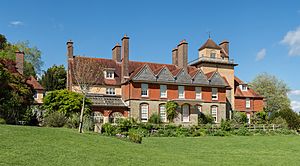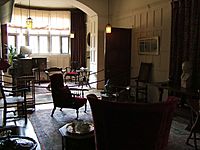Standen facts for kids
Quick facts for kids Standen |
|
|---|---|
 |
|
| Location | East Grinstead |
| OS grid reference | TQ 38968 35598 |
| Area | West Sussex |
| Built | 1892 - 1894 |
| Architect | Philip Webb |
| Architectural style(s) | Wealden vernacular |
| Owner | National Trust |
|
Listed Building – Grade I
|
|
| Official name: Standen | |
| Designated | 28 January 1948 |
| Reference no. | 1249027 |
| Lua error in Module:Location_map at line 420: attempt to index field 'wikibase' (a nil value). | |
Standen is a famous historic house built in the Arts and Crafts style. You can find it near East Grinstead in West Sussex, England. The house and its beautiful gardens are cared for by the National Trust, a charity that protects special places in the UK.
Today, Standen is open for people to visit and explore. It is also a Grade I listed building. This is the highest rating a building can get, meaning it is considered a place of exceptional national importance and must be protected for the future.
Contents
A Look Inside Standen House
Standen was designed to be a comfortable and modern family home, filled with beautiful, handcrafted details.
Designing a Family Home
Between 1891 and 1894, an architect named Philip Webb designed Standen. He built it for a successful London lawyer, James Beale, and his wife Margaret. The Beales had a large family with seven children, so they needed a big house.
Philip Webb was a friend of William Morris, a famous artist and designer. Both men were leading figures in the Arts and Crafts movement. This movement celebrated simple, well-made objects created by skilled craftspeople, rather than mass-produced factory goods.
The house was built using local materials. The stone was taken from the land on the estate, and the bricks and tiles were made nearby. This style, which uses local traditions and materials, is known as Wealden vernacular.
A Modern House for its Time
Standen was very advanced for the 1890s because it had electricity from the very beginning. The power came from a generator run by a donkey engine in a nearby shed. The house still has its original electric light fittings, which were specially designed by William Arthur Smith Benson.
The inside of the house is decorated with carpets, fabrics, and wallpapers created by William Morris's company. These designs are famous for their patterns inspired by nature.
From a Family Home to the National Trust
James Beale passed away in 1912, but his wife Margaret continued to live at Standen. After she died in 1936, their daughter Margaret lived there. When she died in 1947, the house was passed to her younger sister, Helen.
Helen was the last of the Beale family to live at Standen. When she died in 1972, she left the house and its contents to the National Trust in her will. This generous gift ensured that the house would be preserved for everyone to enjoy.
The Gardens and Estate
The land around Standen was just as important as the house itself. The Beales bought three farms in 1890 to create their country estate.
Creating an Arts and Crafts Garden
The Beales began planting their 12-acre (4.9 ha) garden almost as soon as they bought the land. They hired a garden designer, G.B. Simpson, who planned a very formal garden with neat, geometric flowerbeds.
However, the architect Philip Webb had a different idea. He wanted the garden to feel more natural and relaxed. He designed a garden that combined formal elements like hedges and paths with more informal, flowing plantings. The garden uses local stone for its walls and paths, and features trellises and pergolas covered in climbing plants. The result is a beautiful garden that perfectly complements the house.
Standen Wood Nature Reserve
In 2001, the National Trust also acquired Standen Wood, which was once part of the original estate. The woodland had been managed as a nature reserve since the 1970s. It is a peaceful place and an important habitat for many different types of birds.


